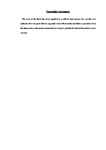The Redundancy Effect in Human Causal Learning: Attention, Uncertainty, And Inhibition
| dc.contributor.supervisor | Jones, Peter M. | |
| dc.contributor.author | Zaksaite, Gintare | |
| dc.contributor.other | Faculty of Health | en_US |
| dc.date.accessioned | 2017-08-08T11:58:21Z | |
| dc.date.issued | 2017 | |
| dc.identifier | 10492201 | en_US |
| dc.identifier.uri | http://hdl.handle.net/10026.1/9693 | |
| dc.description.abstract |
Using an allergist task, Uengoer, Lotz and Pearce (2013) found that in a design A+/AX+/BY+/CY-, the blocked cue X was indicated to cause the outcome to a greater extent than the uncorrelated cue Y. This finding has been termed “the redundancy effect” by Pearce and Jones (2015). According to Vogel and Wagner (2017), the redundancy effect “presents a serious challenge for those theories of conditioning that compute learning through a global error-term” (p. 119). One such theory is the Rescorla-Wagner (1972) model, which predicts the opposite result, that Y will have a stronger association with the outcome than X. This thesis explored the basis of the redundancy effect in human causal learning. Evidence from Chapter 2 suggested that the redundancy effect was unlikely to have been due to differences in attention between X and Y. Chapter 3 explored whether differences in participants’ certainty about the causal status of X and of Y contributed to the redundancy effect. Manipulations aimed at disambiguating the effects that X had on the outcome, including outcome-additivity training and low outcome rate, resulted in lower ratings for this cue and a smaller redundancy effect. However, the redundancy effect was still significant with both manipulations, suggesting that while participants’ uncertainty about the causal status of X contributed to it, there may have been other factors. Chapter 4 investigated whether another factor was a lack of inhibition for cue C. In a scenario where inhibition was more plausible than in an allergist task, a negative correlation between causal ratings for C and for Y, and a positive correlation between ratings for C and the magnitude of the redundancy effect, were found. In addition, establishing C as inhibitory resulted in a smaller redundancy effect than establishing C as neutral. Overall, findings of this thesis suggest that the redundancy effect in human causal learning is the result of participants’ uncertainty about the causal status of X, and a lack of inhibition for C. Further work is recommended to explore whether combining manipulations targeting X and Y would reverse the redundancy effect, whether effects of outcome additivity and outcome rate on X are the result of participants’ uncertainty about this cue, and the extent to which participants rely on single versus summed error. | en_US |
| dc.language.iso | en | |
| dc.publisher | University of Plymouth | |
| dc.rights | Attribution-NonCommercial-NoDerivs 3.0 United States | * |
| dc.rights.uri | http://creativecommons.org/licenses/by-nc-nd/3.0/us/ | * |
| dc.subject | Causal learning | |
| dc.subject | Redundancy effect | |
| dc.subject | Blocked cue | |
| dc.subject | Uncorrelated cue | |
| dc.subject | Attention | |
| dc.subject | Uncertainty | |
| dc.subject | Inhibition | |
| dc.subject | Associative learning | en_US |
| dc.subject.classification | PhD | en_US |
| dc.title | The Redundancy Effect in Human Causal Learning: Attention, Uncertainty, And Inhibition | en_US |
| dc.type | Thesis | |
| plymouth.version | publishable | en_US |
| dc.identifier.doi | http://dx.doi.org/10.24382/602 | |
| dc.rights.embargodate | 2018-08-08T11:58:21Z | |
| dc.rights.embargoperiod | 12 months | en_US |
| dc.type.qualification | Doctorate | en_US |
| rioxxterms.version | NA | |
| plymouth.orcid.id | 0000-0002-1737-2973 | en_US |
Files in this item
This item appears in the following Collection(s)
-
01 Research Theses Main Collection
Research Theses Main



